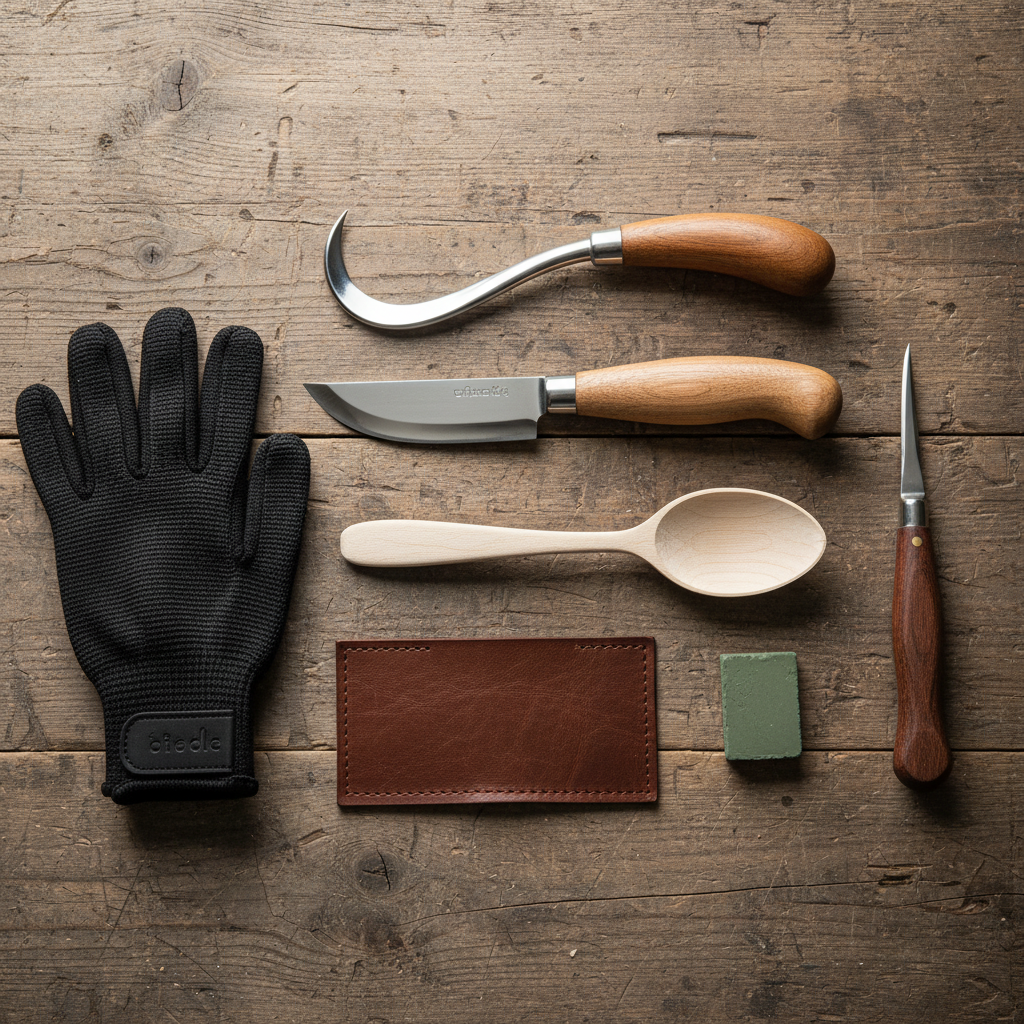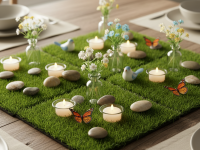Ever dreamt of crafting something beautiful and functional with your own hands? There’s something incredibly satisfying about transforming a simple block of wood into a spoon, a spatula, or a small bowl. Wood carving, especially for spoons and small utensils, is a fantastic entry point into this ancient craft. It’s meditative, rewarding, and surprisingly accessible, but only if you have the right tools. When I first started, I was overwhelmed by the sheer number of options. “What do I really need?” I wondered. Don’t worry, I’ve been there, and I’m here to guide you through selecting the perfect wood carving tool kit to get you started on your journey of crafting beautiful wooden treasures.
There’s a unique joy that comes from using a spoon you’ve carved yourself, or gifting a handcrafted item to a loved one. It’s more than just a hobby; it’s a coection to history, nature, and your own creative spirit. And guess what? You don’t need a huge workshop or expensive power tools to begin. All you truly need is a few sharp knives, a bit of wood, and a willingness to learn. Let’s dive into what makes a great begier’s wood carving tool kit for spoons and small utensils, focusing on the essentials that will set you up for success and countless hours of creative satisfaction.
Why Start with Spoons and Small Utensils?
You might be thinking, “Why spoons? Can’t I just carve a bird or a small animal?” And absolutely, you can! But there are several compelling reasons why spoons and small utensils are often recommended as an excellent starting point for aspiring carvers:
- Accessibility: Spoon blanks are small, easily sourced, and don’t require large logs or complex cutting. You can often find suitable branches or offcuts from local trees.
- Functionality: Unlike decorative carvings, a spoon you make can actually be used in your kitchen every day! This practical outcome is incredibly motivating and provides immediate gratification.
- Skill Building: Carving a spoon teaches you a fundamental range of carving techniques – roughing out, shaping curves, hollowing out, and refining details. These skills are transferable to almost any other wood carving project.
- Minimal Space Required: You can carve a spoon just about anywhere – at a workbench, on your porch, or even in a comfy chair (with proper safety precautions, of course!).
- Cost-Effective: The initial investment in tools is relatively low compared to other woodworking crafts.
Many experienced carvers, myself included, can tell you that their carving journey often began with a spoon. It’s a humble yet powerful teacher.
The Essential Trio: Knives You Can’t Live Without
When it comes to carving spoons and small utensils, you don’t need dozens of tools. In fact, three key knives form the backbone of almost any carver’s kit. Think of them as your core team, each with a specialized role.
1. The Sloyd Knife (Straight Carving Knife)
This is your workhorse. The straight carving knife, often referred to as a “Sloyd” knife (a nod to traditional Scandinavian woodworking education), is incredibly versatile. It’s usually a sturdy knife with a comfortable handle and a straight, fixed blade, often between 2 to 4 inches long. This knife is perfect for:
- Roughing Out: Taking large chunks of wood off to get your basic spoon shape.
- Shaping the Handle: Creating the profile and ergonomic feel of the spoon’s handle.
- Refining the Outer Bowl: Shaping the exterior of the spoon bowl, preparing it for the hook knife.
- General Cuts: Making push cuts, pull cuts, and slicing cuts for overall shaping.
When choosing a sloyd knife, look for one with a high-carbon steel blade (it holds an edge wonderfully and is easy to sharpen) and a handle that feels good in your hand. An ergonomic handle is paramount for comfort during long carving sessions and for precise control.
2. The Hook Knife (Spoon Carving Knife)
This is the specialist tool, designed specifically for hollowing out the bowl of your spoon. A hook knife has a curved blade that allows you to scoop out wood from inside the bowl, creating that satisfying concave shape. There are a few variations:
- Single Bevel vs. Double Bevel: Single bevel knives are sharpened on one side, making them ideal for carving with a specific hand (right or left). Double bevel knives are sharpened on both sides, making them ambidextrous. For begiers, a single bevel designed for your dominant hand is often easier to control.
- Inward vs. Outward Curve: Most hook knives have an inward curve, designed to pull wood towards you or push it away. Some carvers also use an outward curve for specific tasks, but an inward curve is definitely where you should start.
Using a hook knife requires a different technique than a straight knife, and it’s essential to practice safe grips. This knife is designed to create a beautiful, smooth interior to your spoon bowl.
3. The Detail Knife (or Small Straight Knife)
While your sloyd knife can do a lot, a smaller, often more slender straight knife, or a dedicated detail knife, comes in handy for precision work. This knife is great for:
- Fine Details: Cleaning up tight corners, carving subtle transitions, or adding decorative elements.
- Defining Edges: Sharpening the rim of your spoon or perfecting the lines of the handle.
- Trimming: Removing small slivers of wood for a clean finish.
Some begiers might find their sloyd knife sufficient for a while, but once you get comfortable, a detail knife allows for a level of refinement that can elevate your carvings significantly.
Beyond the Blades: Supporting Tools for Smoother Carving
While the three knives are your primary carving instruments, a few other items will make your carving experience safer, more enjoyable, and more effective.
1. Cut-Resistant Carving Glove
I caot emphasize this enough: Always wear a cut-resistant glove on your non-carving hand. Your non-dominant hand is often holding the wood, bracing the knife, and is most vulnerable to slips. A good glove, made from materials like Kevlar or Dyneema, can prevent a nasty trip to the emergency room. Trust me, it’s a small investment that offers huge peace of mind.
2. Sharpening Stone and Leather Strop
A dull knife is not only frustrating but also dangerous. A dull blade requires more force, increasing the risk of slips and injury. Sharpening and stropping are fundamental skills every carver must learn. Your kit should include:
- A Sharpening Stone: A dual-grit stone (e.g., 1000/6000 grit) is a great starting point. The coarser side reshapes the edge, and the finer side refines it.
- A Leather Strop with Polishing Compound: A strop is used to “hone” the edge, removing microscopic burrs and making your knife incredibly sharp. Regular stropping means less frequent sharpening, saving your blade’s life.
Learning to sharpen is part of the craft, and there are countless tutorials online to guide you.
3. Workholding (Optional, but Recommended)
While you can hold smaller pieces of wood by hand, using a clamp, a small bench vise, or a carving horse offers stability and frees up your non-dominant hand (still wear that glove!). Stability means more control, better cuts, and reduced fatigue.
4. Pencil and Templates
Before you make a single cut, you need a plan. A simple pencil to sketch your spoon design directly onto the wood, and perhaps a few reusable templates (made from cardboard or thin plastic) to help you get consistent shapes, are incredibly useful. It’s much easier to erase a pencil line than to correct a misguided cut!
Choosing Your First Kit: What to Look For
Now that you know what tools you need, how do you go about acquiring them? You have two main options:
- Buy a Begier’s Kit: Many reputable brands offer starter kits that include a sloyd knife, a hook knife, and sometimes a sharpening strop or a glove. These are convenient and often more cost-effective than buying individual tools.
- Assemble Your Own: If you want more control over individual tool quality or have specific preferences, you can buy each tool separately.
Regardless of your approach, here’s what to prioritize:
- Quality Steel: Look for high-carbon steel blades. They hold an edge well and are relatively easy to sharpen. Stainless steel can be okay, but often doesn’t hold an edge as long.
- Ergonomic Handles: This is crucial for comfort and control. Wood handles are traditional and often preferred, but composite materials can also be good. The handle should feel balanced in your hand.
- Reputable Brands: Do a little research. Brands like Morakniv, BeaverCraft, and Flexcut are popular among begiers and experienced carvers alike for their quality and value. Don’t fall for super cheap, no-name tools; they’ll quickly dull, frustrate you, and potentially be unsafe.
- Read Reviews: See what other begiers are saying about specific kits or tools.
Safety First: Protecting Your Hands (and Project)
I can’t stress this enough: wood carving can be dangerous if not approached with respect and caution. A sharp knife is an extension of your hand, but it demands proper technique. Here are some non-negotiable safety rules:
- Always Wear Your Carving Glove: Yes, I’m repeating myself, because it’s that important!
- Carve Away From Your Body: This is carving 101. Never make a cut where the blade is heading towards any part of your body.
- Use Proper Grips: Learn different grips for different cuts (e.g., push cuts, pull cuts, thumb assist). Control is key.
- Keep Tools Sharp: A sharp tool cuts cleanly and requires less force, reducing the chance of slips.
- Stable Work Surface: Ensure your wood is stable. If holding by hand, use a controlled grip. If clamped, ensure it won’t budge.
- Clear Your Workspace: Avoid distractions and clutter.
- Have a First Aid Kit Handy: For those inevitable nicks and cuts, a basic first aid kit is a must.
Think before you cut. A moment of hesitation can save you from a preventable injury.
Maintaining Your Tools: Keep Them Sharp, Keep Them Safe
Your carving tools are an investment, and proper maintenance will ensure they last for years and perform at their best. Just like a chef sharpens their knives, a carver must do the same.
- Sharpen Regularly: How often depends on the wood you’re carving and how much you carve. As soon as you feel the knife dragging or tearing the wood, it’s time for a touch-up on the stone.
- Strop Frequently: Stropping is your daily maintenance. A few passes on a leather strop after every carving session (or even during one) will keep the edge razor-sharp and extend the time between full sharpening sessions.
- Clean and Oil: After use, wipe down your blades to remove any sap or moisture. If you live in a humid environment or won’t be carving for a while, a light coat of camellia oil or mineral oil will prevent rust.
- Store Safely: Keep your sharp tools in a sheath, tool roll, or a designated box to protect the edges and prevent accidental cuts.
Treat your tools well, and they will serve you faithfully.
Ready to Start Carving? Tips for Your First Project
You’ve got your kit, you’re armed with knowledge, and you’re ready to make some shavings! Here are a few final tips for your very first spoon:
- Start with the Right Wood: Begiers often find “green wood” (freshly cut wood that hasn’t dried out) much easier to carve than seasoned hardwood. Birch, sycamore, cherry, apple, and basswood are excellent choices. They’re soft enough to carve easily but still hold detail.
- Watch Tutorials: YouTube is an incredible resource. Search for “begier spoon carving tutorial” and watch a few different styles. Seeing the cuts in action can be incredibly helpful.
- Don’t Rush: Carving is a meditative process. Enjoy each cut, each curve. Don’t worry about speed or perfection on your first attempt.
- Embrace Imperfections: Your first spoon won’t be perfect, and that’s okay! Those little facets and irregularities tell a story. They’re part of the charm of handmade items.
- Practice, Practice, Practice: Like any skill, carving improves with time and repetition. Don’t get discouraged if your first few attempts aren’t exactly what you envisioned.
Conclusion
So there you have it – your roadmap to diving into the wonderful world of spoon and small utensil carving. Getting the right tool kit isn’t just about buying knives; it’s about investing in your creativity, your safety, and the immense joy of making something tangible with your own hands. Remember, a sharp tool, a safe practice, and a dash of patience are your best friends on this journey. Don’t be afraid to make mistakes; they’re part of the learning process, and each one brings you closer to mastering this beautiful craft.
Grab your kit, find a comfy spot, and let the wood speak to you. The world of wood carving is waiting for you to make your mark. Happy carving!



